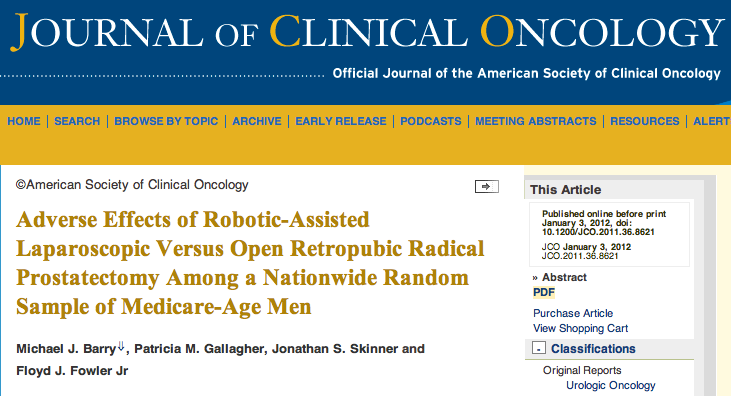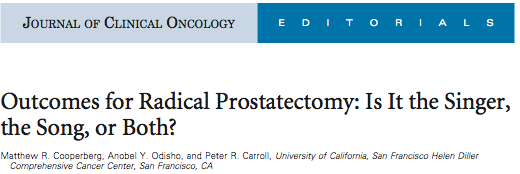Robotic Assisted Prostate Surgery does not lead to fewer complications
A survey of patients who had their prostate removed showed there was no significant difference in complication rates between open retropubic radical prostatectomy (ORRP) and robotic assisted laparoscopic surgery (RALRP).
 This is an important finding because 85% of prostatectomies in the United States are undertaken using robotic-assisted techniques, yet there has been little published data to show that this technique improves functional outcomes.
This is an important finding because 85% of prostatectomies in the United States are undertaken using robotic-assisted techniques, yet there has been little published data to show that this technique improves functional outcomes.
At the European Association of Urology (EAU) annual congress last year in Vienna some of the challenges and opportunies with robotic surgery were raised:
- lack of data on improved functional outcome
- need for licensing of robotic surgeons
- high learning curve – it takes 250 patients to become proficient
In reality, we see hospitals marketing their robotic surgery to patients in shopping malls and with advertisements on the side of buses. You can read Gary Schwitzer’s thoughts on some of the recent marketing claims & “gizmo idolatry.”
This is why a survey comparing the results of open to robotic assisted prostate removal surgery is important evidence based medicine. Published online first in the Journal of Clinical Oncology, Barry and colleagues randomly surveyed 800 men who filed Medicare claims between August and December 2008. 685 completed surveys were returned, and information on adverse events was obtained.
The data highlights the dramatic effect on quality of life that prostate cancer surgery can have, irrespective of the surgical technique. The men rated themselves:
31.1% – moderate or big problem with continence (95% CI 27.5 to 34.8%)
88.0% – moderate or big problem with sexual function (95% CI 85.4% to 90.6%)
Breaking this down by technique (robotic surgery versus open prostatectomy):
Continence: 27.1% of men (Open) versus 33.3% (Robotic) – not significant (P=0.113)
Sexual Function: 89.0% of men (Open) versus 87.5% (Robotic) – not significant (P=0.57)
The authors conclude in their JCO paper:
Our results do not demonstrate a lower risk of problems with incontinence or sexual function after RALRP compared with ORRP.
In fact, after adjusting for potential confounders, there was at least a strong trend toward a higher risk of patient-reported moderate or big problems with incontinence following RALRP.
The authors in their discussion do raise the interesting question as to whether patients were led to believe that they would have fewer side effects with robotic surgery, which may have impacted the survey findings. This merits further investigation.
There is clearly a need for patients to give informed consent, and be aware of the risks and complications of prostate cancer surgery, particularly with regards fundamental quality of life issues such as continence or sexual function.
 The accompanying JCO editorial by Matthew Cooperberg and colleagues from UCSF is well worth reading and raises the question as to whether men with prostate cancer should expect better outcomes than those reported in the survey?
The accompanying JCO editorial by Matthew Cooperberg and colleagues from UCSF is well worth reading and raises the question as to whether men with prostate cancer should expect better outcomes than those reported in the survey?
What the survey by Barry et al did not do is look at the volume of procedures and experience level of the surgeon, both of which are associated with outcomes.
Cooperberg noted that “surgeons performing fewer than 5 prostatectomies per year account for approximately half the national volume.”
A chilling statistic, and if you factor in the learning curve of more than 200 procedures to be competent at robotic surgery, it is perhaps not surprising that some men experience higher complication rates than others.
Which brings me back to the importance of the PIVOT (Prostate Cancer Intervention versus Observation Trial) data presented in the plenary session at the 2011 annual meeting of the American Urological Association (AUA) in May last year.
Why has this practice changing data not been published in a peer-reviewed journal yet?
The fact that the updated PIVOT study results presented at AUA 2011 have not been published (to the best of my knowledge) is a disservice not only to the medical and scientific community, but to men with prostate cancer whose treatment should be guided by evidence-based medicine.
The long-term results of the PIVOT trial presented by Professor Wilt showed no benefit of radical prostatectomy over watchful waiting, except for high-risk patients. Yet, the reality is that many men end up having surgery. This may be considered overtreatment and an exposure of more men than is necessary to the complications of prostatectomy, irrespective of whether this is robotic or open surgery.
The decision to undergo radical prostatectomy should be an informed one, not only as to the risks and benefits of the surgical technique, but also whether the surgery should be performed in the first place as compared to “watchful waiting.”
I hope the paper and editorial published in the JCO this month will generate some debate. Next month I will be at the European Urology Association annual congress in Paris.
References
![]() Barry, M., Gallagher, P., Skinner, J., & Fowler, F. (2012). Adverse Effects of Robotic-Assisted Laparoscopic Versus Open Retropubic Radical Prostatectomy Among a Nationwide Random Sample of Medicare-Age Men Journal of Clinical Oncology DOI: 10.1200/JCO.2011.36.8621
Barry, M., Gallagher, P., Skinner, J., & Fowler, F. (2012). Adverse Effects of Robotic-Assisted Laparoscopic Versus Open Retropubic Radical Prostatectomy Among a Nationwide Random Sample of Medicare-Age Men Journal of Clinical Oncology DOI: 10.1200/JCO.2011.36.8621
Cooperberg, M., Odisho, A., & Carroll, P. (2012). Outcomes for Radical Prostatectomy: Is It the Singer, the Song, or Both? Journal of Clinical Oncology DOI: 10.1200/JCO.2011.38.9593
Update August 12, 2012 – Paper published in European Urology shows lower incontinence and greater rate of erection recovery with robot-assisted radical prostatectomy
A paper published online (July 20, 2012) in the journal, European Urology by Franceso Porpiglia provides some evidence that robot-assisted radical prostatectomy offers functional benefits to patients. I have not read the full paper only the freely available abstract.
The clinical trial evaluated the functional outcomes of 120 men in a randomized clinical trial where half (n=60) received radical prostatectomy (RARP) that was robot-assisted and the other half (n=60) who had the operation laparoscopically without robot assistance (LRP).
Following the surgery performed by Dr Porpiglia, the functional outcomes between the two groups were compared. Those men operated on with robot assistance showed:
- Lower incontinence. “Continence after 3 mo was 80% in the RARP group and 61.6% in the LRP group (p = 0.044), and after 1 yr, the continence rate was 95.0% and 83.3%, respectively (p = 0.042)”
- Better erection recovery. “Among preoperative potent patients treated with nerve-sparing techniques, the rate of erection recovery was 80.0% and 54.2%, respectively (p = 0.020).”
The challenge of this study is that although it was randomized, it reflects the results of only one surgeon with a small number of patients.
Dr Matthew Cooperberg (@cooperberg_ucsf) was quoted by Reuters saying that this was likely the best study we were going to get showing the benefits of RARP over LRP. On twitter he said the real question was now between radical prostatectomy and external radiation therapy (XRT).
https://twitter.com/cooperberg_ucsf/status/233427660708126721